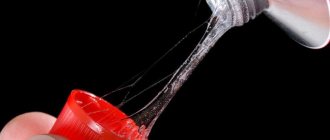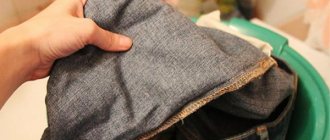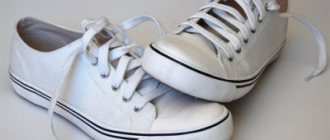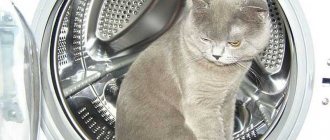Home page » Home and comfort » Wardrobe care
Author of the article
Svetlana Pavlikhina
Reading time: 6 minutes
AA
No one is immune from the appearance of tar stains on denim clothing. They can appear after walking on an asphalt road and even while walking in the forest.
Getting rid of them is problematic, but possible. The main thing is to know how to remove tar from jeans and what products can be used.
Where to start cleaning
To wash the resin of pine or other types of wood, you must first prepare the stained item for cleaning:
- Use a spoon or the blunt side of a knife to scrape off the top layer of resin.
- Use a dry brush to remove dust and dirt from the fabric (this will prevent streaks from appearing).
If the garment has a lining, it should be ripped open to treat only the stain without touching the clean fabric.- Place the matter on the board.
- Moisten the material around the stain and sprinkle with starch (this will prevent further spread of the stain).
First aid
Resin is a viscous and quite sticky substance. Before it hardens, it can smudge, stain other things, and dust and debris easily stick to it. Therefore, the first thing to take care of is to try to avoid making the situation worse.
If possible, try to remove most of the sticky composition. This can be done, for example, using wet wipes.
Resin should be removed from the edges to the middle of the stain , and upwards. By acting in this way, you will be able to avoid extensive smearing of the sticky mass on your denim pants.
Temperature effect
Pine resin and viscous contamination from poplar can be removed under the influence of temperatures. Cleaning is done by freezing or heating.
Freezing resin
The viscous substance becomes brittle at low temperatures and can be easily removed. To do this you need to do the following:
- Place ice cubes, packed in a bag, on the inside of the jeans.
- Wrap the clothes themselves in plastic.
- Place the item in the freezer for an hour and a half.
- Remove jeans and print.
- Remove the stain: the resin will crumble and be easily shaken off the fabric.
- Remove the remaining particles of the frozen mass with a brush.
Heating with an iron
Fresh dirt can be easily removed with high heat.
You need to do the following:
- Wrap the board in cloth.
- Put the thing down.
- Place a napkin on top.
- Set the iron to medium heat.
- Iron the stain.
- Periodically replace the napkin with a new one.
- Perform these steps until the stain disappears completely.
You can use a hairdryer: a hot stream of air is directed at the dirt, the resin is melted and cleaned off with a napkin.
Delete it once or twice
The previous methods will be relevant for delicate fabrics that simply cannot be handled harshly.
If you are looking for how to remove resin from old clothes, or from a pair of jeans, study the following recommendations.
Alcohol
This is not only a disinfectant, but also an excellent solvent that should be in every housewife’s arsenal to get rid of stubborn stains.
Soak a cotton pad in alcohol, rub the stain if it is fresh, or leave the swab on the fabric for 20 minutes if the substance has already hardened for a long time.
The same principle applies to acetone, kerosene, turpentine and gasoline.
After applying lotions made from compounds with a strong odor, keep the item under running cold water for a while, and then wash it in a machine using conditioner.
Bomb mixture: turpentine-ammonia-starch
This paste can save clothes made from delicate and natural fabrics.
You will need:
- 1 tbsp. l. potato starch,
- 1 tsp. turpentine,
- 1 tsp. ammonia.
Mix everything and apply to the product for 12 hours. After time has passed, clean off the dried solution along with the resin juice.
Soda
Do you know the difference between an experienced housewife and a young one? A set of life hacks. Obviously, not every woman knows how to clean pine resin from clothes. And we’ll give you a hint – Coca-Cola.
The composition of this carbonated drink is kept in the strictest confidence, but it should be sold in departments with household goods rather than in soft drinks.
We have already told you that with the help of Cola you can clean the inside of a kettle from scale, and now you can clean forest gifts from things.
The instructions are incredibly simple: pour magic nectar into a basin, soak the little thing in it for 5 hours, and then wash it in the machine.
Vegetable oil
This product is suitable for leather products. For example, if a tree in the forest marks your favorite biker jacket, do this:
- Dip the sponge into the oil;
- Apply it to the contaminated area;
- After 20 minutes, wipe clean with soapy water.
Dishwashing liquid
Will save woolen products. Take the oil to join him and do everything as in the previous point, only instead of soap, apply detergent at the end. The final step is traditionally machine washing.
White spirit
Considered the best solvent. It will help remove not only resin traces, but also rosin and bitumen. An indispensable item for skilled men.
After treatment, you need to wash thoroughly with powder and conditioner.
Stain remover
Sometimes he will be able to solve such a problem. Soak for a while, and then send to wash. If the problem persists, return to one of the steps above.
Removing stains when washing
After preliminary preparation, contamination can be removed by washing. The main thing is to choose effective means that can remove it .
Vegetable oil
This affordable product is considered a gentle remedy. Mode of application:
- Apply a small amount of oil to the resin.
- After 15 minutes, the surface is cleaned with soapy water and a brush.
- The item is washed in the usual way.
Laundry soap
The cleaning procedure is simple and boils down to the following steps:
- The fabric is moistened with warm water.
- The resin is rubbed with soap.
- The fabric is kept in this state for a quarter of an hour.
- After the specified time, the item is rinsed.
- The procedure is repeated again.
Lemon acid
Under the influence of acid, the substance softens.
The cleaning procedure is carried out according to the following scheme:
- Citric acid is mixed with water in equal proportions.
- The resulting mass is applied to the contamination.
- Ten minutes later, the clothes are washed in an automatic machine.
Dishwashing liquid
In the fight against resin, household chemicals give good results. For example, the well-known Fairy. It contains components that can dissolve organic contaminants.
Stages of using the product:
- A few drops of the substance are applied to the resin.
- After 15 minutes the item is rinsed.
- Jeans are washed using washing powder.
Alcohol
You can remove resin from clothes with regular alcohol or vodka. The method is good and safe for any thing, but not always effective.
Sometimes it is necessary to carry out several procedures to remove resin from clothing.
How to remove a stain:
- Lay the item out on a flat surface. Place a clean and preferably dense piece of unnecessary material under the contamination.
- Soak part of the bandage with alcohol or vodka and wipe the stained area. Don't be afraid, rub harder. Apply the moistened bandage to the contaminated area for half an hour. Then wipe off anything that has dissolved.
- Rinse off the residue under running water, then wash the item using powder and fabric softener.
Alcohol, unlike vodka, can not only remove resin from clothes, but also corrode the dye.
If the pine resin stain is still fresh, then the most effective way to get rid of the stain is to use alcohol and a cotton pad.
After which the “saved” item is sent to the washing machine.
This method will be effective even for light-colored items, since they are not afraid of the effects of the alcohol base.
Use of solvents
Not all known means can cope with severe stains. We have to resort to the use of aggressive substances - solvents.
The most effective of them:
- acetone;
- turpentine;
- petrol.
Solvents can lighten the fabric, so before cleaning, you should test their effect on a small area of the jeans in an inconspicuous place.
Removal is carried out in several stages:
- A cotton swab is soaked in the solvent and the areas with resin are treated.
- After a quarter of an hour, the item is washed first by hand and then by machine.
- The jeans are dried in the fresh air (this removes the sharp, unpleasant smell of the solvent).
What is it like?
Most often you have to scrub epoxy resin off your hands. It is a strong adhesive that holds different types of materials together. With the help of this substance it is possible to fix wood or plastic. When carrying out work, epoxy resin is used in the form of a liquid. But after a certain time it freezes.
In case of contact with skin, it is recommended to immediately carry out cleansing procedures. With prolonged contact there is a risk of irritation and swelling of the dermis. The substance can also provoke allergic reactions, hyperemia, lacrimation, and damage to the respiratory system.
It is important to consider that epoxy resin is a carcinogenic substance that leads to intoxication of the body
Factory stain removers
Special stain removers can cope with the task. You need to choose a product suitable for processing denim.
You need to do the following:
- Read the instructions and the safety precautions described therein.
- Apply stain remover to the stain.
- Leave for about half an hour. The duration of the procedure largely depends on the strength of the components included in the product. The exact time is indicated on the packaging. There is also information about dosage.
- Jeans are machine washed with the addition of the same stain remover.
Pre-cleaning
First, mechanically clean your clothes. To avoid damaging the fabric, it is better to use a wooden or plastic spatula. Use it to scrape off the sticky substance that is stuck to the fabric. It is better to avoid using sharp objects as they can damage your jeans.
Important! Clean only at home, using clean tools. Resin is a sticky substance and other things, including dust and debris, will quickly stick to it. In this situation, it will be much more difficult to remove contamination.
When the bulk of the contamination has been removed, choose the method in which you will clean the resin from the jeans.
Other resin removers
List of means that can be used to remove resin from clothes:
- Sweet sparkling water. The maximum effect is observed when using Coca-Cola. Jeans need to be placed in a basin, pour soda into it and soak the item for five hours, then clean the resin with a brush. The method is considered gentle and safe. No sharp objects are used when using it. The dirt softens and can be easily removed with a regular brush.
Alcohol. Soak cotton wool or gauze in the liquid and apply the product to the stain. The item is kept for about half an hour. It's not worth a lot of alcohol. The main thing is that the contaminated area is wet. After treatment, clothes should be rinsed and washed.- White spirit. The product is absolutely safe and will not harm denim fabric. It must be applied to the resin and wait until the contamination is completely dissolved.
- Milk. It is enough to soak the contaminated area of fabric in milk for an hour, and then wash the clothes in regular cool water. There will be no trace left of the stain.
Prohibitions
When cleaning denim trousers, it is necessary to take into account a number of prohibitions:
- The use of sharp objects (knife, blade) is only allowed to a limited extent to cut off the top volumetric layer of resin. The lower part of the stain, which is in direct contact with the fabric, cannot be removed in this way, as there is a risk of damage to the material.
- You should not try to wash a fresh stain under running water, as this will only lead to even more smearing of the resin on the jeans.
- You should not pour or pour everything that is at hand onto the stain. The effect of such an impact will not be predictable. Possible damage to the fabric, loss of brightness of the jeans.
What not to do
When cleaning denim clothes, you need to know what actions cannot be performed, otherwise the item will be damaged.
This:
- Do not put clothes into the washing machine without first treating the tar stain: it will not wash off and will spread over large areas.
- Do not rub the stain too hard, otherwise the viscous substance will penetrate deep into the fabric and make cleaning more difficult. If the jeans are light, then it is almost impossible to remove dirt from them after this.
- Don't leave cleaning for later. Contamination should be removed as quickly as possible, otherwise the substance will penetrate deep into the tissue structure and will be more difficult to remove .
How and with what to clean tree resin from wood from clothes?
Wood resin is quite liquid and can eat into fabric.
Methods for removing tree resin:
- Nail polish remover
- Acetone
- Paint thinner
- Vegetable oils
How and with what to clean tree resin from wood from clothes?
Additional recommendations
For the procedure to be safe and effective, you must adhere to the following recommendations:
- when using flammable materials, all actions are performed at a sufficiently large distance from sources of fire;
- clothing is processed from the reverse side;
- a substance used for the first time is tested on an inconspicuous area and only if there are no negative changes is used to remove the stain;
cleaning is carried out from the edge of the contamination to the center: due to this, it will be possible to prevent its increase in diameter;- You need to perform careful blotting movements;
- You cannot use gasoline when processing stretch;
- Apply the cleaning agent to small spots with a pipette or a cotton swab;
- To get rid of the unpleasant smell of cleaners when washing clothes, use conditioner;
- dry your jeans in the fresh air.
By following all the recommendations, strictly following the instructions and choosing the right products, you can easily remove resin from denim.
The main thing is not to rush, to maintain the specified dosage of substances, otherwise the situation will only worsen and your favorite thing will deteriorate.
Previous
Wardrobe careShoes rub your heels: causes and methods of solving the problem
Next
Caring for your wardrobeWashing a dress made of natural silk: rules and step-by-step instructions for hand and machine washing
What not to do with a resin trace
Before choosing how to remove tree sap from clothes, you should consider some important factors, otherwise you may accidentally damage the item irrevocably.
Before using one of the suggested cleaning methods, you need to scrape off the resin itself. All the proposed options are aimed at getting rid of its traces, but none of them will help get rid of it completely, without preliminary cleaning.
Brightly colored items made from delicate materials should not be cleaned with alcohol or any acids, because they can discolor the fabric at the point of contact. Vinegar, even diluted with water, should not be used on silk fabric. Strong alkaline solvents and especially bleaches are safe to use only for white things, otherwise the color will begin to peel off. Turpentine or gasoline are only suitable for rough fabrics
It is rational to use them for jackets, trousers and other things that do not require careful handling. They are also most suitable for hiking clothing, which is made from durable materials - gentle products may be ineffective. To prevent the stain from spreading further during the cleaning process, you can moisten the cloth around it with plain water or sprinkle it with starch/talcum powder. The directions of movements when cleaning should be from the edge to the center, and not vice versa, otherwise the dirt will spread and be firmly absorbed. It is advisable to clean from the inside out and move to the front side.
Before doing this, make sure that the fabric is not discolored. It is not advisable to leave the product on for longer than the recommended time, otherwise it may begin to corrode the fabric.
Since resin can be dissolved using different methods, the item stained with it will not be damaged forever
It is only important to know which methods are suitable for a particular material, as well as to have the necessary tools at hand. Even for delicate fabrics there are safe options with which the item will return to its normal state
In any case, you shouldn’t worry and throw away the item if there is a chance to save it. There are many ways to get rid of tar stains, and one of them will definitely help.
Preparing for cleaning
Having discovered a dark tar stain on the leg or sleeve of a blouse, the first thing you need to do is remember how it could have appeared. If trouble occurs after a walk in a park planted with coniferous trees, or while picking mushrooms in a pine forest, then we are talking about tree resin. It’s another matter if the stain appeared during repairs or after going to a construction site. In this case, we can assume that the resin is epoxy.
Resin type – wood (natural) or epoxy
There are two types of resins: natural, or wood, and synthetic. But they are all characterized by incredible stickiness, the ability to quickly penetrate the fabric fibers and glue them together.
Before cleaning begins, it is necessary to correctly determine the type of resin.
Vegetable stains are much easier to remove than stains caused by epoxy resin.
Fabric material
To select a cleaning product, it is important to know what fabric the stained jacket or blouse is made of. Otherwise, a hole may form in place of the stain, the paint may peel off, or some other problem may occur.
The composition of the material and methods of caring for the product are indicated on the label. If the information is erased or the label is cut off immediately after purchase, you should follow these rules:
Fresh or old stain?
A fresh stain that has just appeared is always easier to remove than an old one. Therefore, as soon as a resin blot is discovered, you must immediately begin cleaning:
Fresh stains usually have a blurred outline and are darker in color than the fabric. Old stains have a clear outline, they are lighter than the fabric, and appear both from the face and from the inside.
How to prepare things for stain removal?
Before applying the cleaning agent, the affected product must be prepared as follows:
The product is ready for cleaning. Now all you have to do is choose the right tool - and you can get to work.











